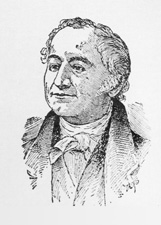John Rutherfurd
John Rutherfurd (born September 20, 1760 in New York City , † February 23, 1840 in Rutherfurd , New Jersey ) was an American politician who represented the state of New Jersey in the US Senate .
Life
origin
Rutherfurd came from a noble family known at the time who had immigrated to the USA from England and Scotland . He was the son of Walter and Mary Rutherfurd and, through his mother, the nephew of William Alexander, Lord Stirling . Rutherfurd was also related to Gilbert Elliot-Murray-Kynynmound, 1st Earl of Minto , who was Governor General of India from 1807 to 1813 . Another relative of Rutherfurd was William Eden, 1st Baron Auckland , who was among other things British ambassador to Spain and the Netherlands .
American politicians were also among Rutherfurd's distant relatives, including John Elliot , who was governor of Newfoundland from 1786 to 1789 , and Arthur St. Clair , who was governor of the Northwest Territory from 1799 to 1802 .
Career
After attending Princeton University , where he graduated in 1779, Rutherfurd studied law and was admitted to the bar in 1784. After about three years of practicing law in New York, Rutherfurd moved in 1787 to a farm near Allamuchy on the border between Sussex County and Warren County, New Jersey.
Rutherfurd made his first political appearance only a year later, when he was one of those electors who elected George Washington as the first President of the United States in 1788 . At that time, Rutherfurd was part of the pro-administration faction that later became the Federalist Party .
In 1788 Rutherford was elected to the New Jersey General Assembly and held that office for just under a year until 1789. 1790 candidate Rutherfurd successfully for the office of US Senator and moved to the then in March 4, 1791 Philadelphia meeting participants Congress one. Although he was successfully re-elected in 1796, Rutherfurd resigned his mandate on December 5, 1798; he was succeeded by Franklin Davenport .
Late life
After 1798, Rutherfurd largely withdrew from politics. He became president of the patent office in eastern Jersey in 1804, an office he held until his death 36 years later. In 1807 he took over the legal direction of the Commissioners' Plan of 1811 , which in 1811 was to put into practice the characteristic map of New York City that visitors to the metropolis can still find today. He also invested in the construction of a canal that was to connect the Delaware River with the Raritan and Hudson Rivers around 1816 .
Another important project in which Rutherfurd was involved began in 1827 and was supposed to fix the borders between New Jersey and the neighboring states of New York and Pennsylvania that still exist today in a six-year diplomatic process that was concluded in 1833 .
Family and death
John Rutherfurd married Helena Morris, the daughter of Lewis Morris , one of the signatories of the Declaration of Independence , in 1782, at the age of 22 . The 58-year marriage resulted in eight children. One of them, son Robert Walter Rutherfurd, served in the New Jersey Chamber of Deputies. Robert's son and John Rutherfur's grandson was the astronomer Lewis Morris Rutherfurd (1816-1892).
John Rutherfurd, who was the oldest surviving former member of the US Senate from March 7, 1838 until his death - his term ended 41 years earlier - died at the age of 80. His grave is now in Belleville, New Jersey.
legacy
Those farm that manage the Rutherfurds, soon evolved into a city that originally in honor of the US politician Rutherf u rd was baptized. But the U soon developed into an O in common parlance . As 1876 Rutherford B. Hayes became the US president elected, the city fathers of the city took Rutherfurd this opportunity, the name of the city on Rutherf o rd to change. Today the small town has around 17,600 inhabitants.
Web links
- John Rutherfurd in the Biographical Directory of the United States Congress (English)
| personal data | |
|---|---|
| SURNAME | Rutherfurd, John |
| BRIEF DESCRIPTION | American politician |
| DATE OF BIRTH | September 20, 1760 |
| PLACE OF BIRTH | New York City , New York |
| DATE OF DEATH | February 23, 1840 |
| Place of death | Rutherfurd , New Jersey |

